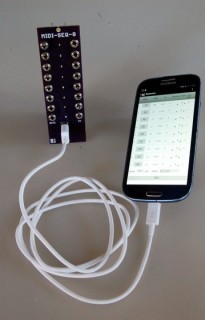
Pmfoundations has introduced Midi-Seq-8, a Eurorack Android to analog synth interface; and a companion Android app, MIDI Sequencer.
The Interface is sold as a full kit, consisting of a set of 2 high quality PCBs, front panel, all basic and precision components and a pre-programmed PIC processor.
The developer says that “The Midi-Seq-8 delivers the convenience of a smartphone or tablet-driven sequencer that directly controls your analog monophonic synthesizer from your Android device.”
Features:
- 8 MIDI channels supported which can drive 8 synth voices
- Play your own MIDI compositions on your synth from your phone
- Create and play CV sequences up to 16 steps on 8 channels
- Gate or Trigger mode
- Adjustable Clock in BPM
- Start / Stop /Rewind / Step
- 8HP wide
The module connects to your Android device using a micro USB cable. It uses a PIC 24 bit microprocessor to convert MIDI messages from the Android app into digital codes which are then converted into gate/trigger and control voltages for 8 channels with TI DACs. These are buffered with precision TI op amps, providing precise tracking over three octaves and to within 0.01V over 5 octaves.
The Interface is available via Pmfoundations for US $149, and the software is a free download via the Google Play store.
If you’ve used the Midi-Seq-8, leave a comment and share your thoughts on it!
via FSK1138

great price ! perfect size !
i am hoping to see more functionality from this device as it becomes more widely adopted
wishlist: longer step count , LFO , clock divider , function generator
i got this reply last night from John French
————————————————
Regarding your questions:
1) Increasing the number of steps is trivial and requires only an
Android update;
2) The module can already control LFOs. All that is required is to set
the tuning of the LFO to the frequency range required although this
would not be directly reflected in the UI of the app;
3) Clock divider functionality is provided in the app. by a speed
setting on the sequence and also with a tempo selector on the playback.
4) I do not fully understand your requirement about decoupling the Gates
from the CVs. but all the outputs are controlled by the firmware in the
PIC microprocessor so if you can specify the requirement in more detail,
I can incorporate it in a future release or even as a custom chip.
Because the PIC is central to the behavior of the outputs, it is really
easy to change what the module does without having to change any
components or circuitry. I think this is one of the great advantages of
this module, especially since the user, if willing to write their own
firmware in the Microchip MPLAB-X development environment, can program
the module to do what ever they want.
https://www.microchip.com/mplab/mplab-xpress#utm_medium=Press-Release&utm_term=MPLAB%20Xpress&utm_content=MCU8&utm_campaign=Xpress
Thank you for your interest and support.
John.
Great info – thank for sharing this!
Wonder if there will be an API for it. Seems other apps (and devices) might want to communicate with this as well.
An API is possible but in the meantime I will happily share interface specifics and source code so people can write their own apps. After all, the app is free and very basic, just to provide a simple demonstration of capabilities. There are vastly more advanced software sequencers out there that can be adapted.
Nice, also PCB option for us DIYers, thanks Will be ordering one of these soon.
Will be ordering one of these soon.
Yes. You can order just the PCBs if you have a good stock of components and you can leave out the more expensive stuff if you know what you are doing. Always happy to help with suggestions. Just email me at personalcircuits@pmfoundations.com